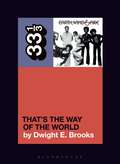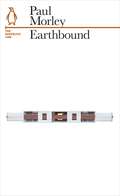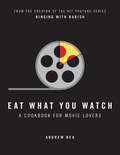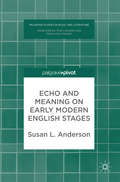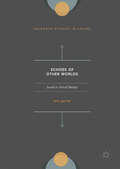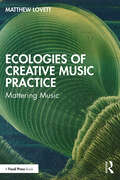- Table View
- List View
Earshot: Perspectives on Sound
by Bruce JohnsonEarshot: Perspectives on Sound awakens an understanding of the decisive role that sound has played in history and culture. Although beginning with reference to antiquity, the primary focus is the changing status of sound and hearing in Western culture over the last six hundred years, covering the transition from the medieval period to the contemporary world. Since mythic times, sound has been an essential element in the formation of belief systems, personal and community identities and the negotiations between them. The varied case studies included in the book cover major reference points in the changing politics of sound, particularly in relation to the status of the other major conduit of social transactions, vision. Earshot is not a work of cultural theory but is anchored in social practices and material culture and is therefore a valuable resource for conveying sound to both undergraduate students as well as the general reader.
Earth to Moon
by Moon Unit ZappaThe saying goes that "God only gives you what you can handle." Well God didn't grow up in my atheist, Wiccan, fame-laden, oversexed, teetotalling, drug-free, cloistered, chaotic, non-communicative, workaholic, feral-feeling house.'For Moon Unit, daughter of musician Frank Zappa and his 'manager', Gail, processing a life so unique, so punctuated by the whims of creative urges, the tastes of popular culture and the calculus of celebrity, has at times been eviscerating. But it is her deep sense of humour and unshakeable humility that keeps her - and this memoir - pinned to the ground.A child-star at age 14 after her accidental international hit single (recorded with her father), 'Valley Girl', turned her into a reluctant celebrity, Moon Unit Zappa's life has been utterly extraordinary from her birth in 1967 into a family that was already blessed/cursed as music royalty thanks to the acknowledged genius of Frank. But what are the consequences of growing up in a family who spend most of their time naked arguing about sexual/extra-marital liaisons and practising white magic in a free-for-all state of nonconformist, virtuoso abandon?Earth to Moon is a reckoning with self-esteem, the ghosts of the past and a mother and a father who, in the process of leaving their mark upon on the world, scarred their first daughter on home soil. Brutally self-deprecating and funny as hell, it belies a rose-tinted perspective on the 70s and 80s west coast American scene, from within the belly of the beast of the rock and roll world.
Earth, Wind & Fire's That's the Way of the World (33 1/3)
by Dwight E. BrooksUnderstanding That's the Way of the World requires appreciating Earth, Wind & Fire founder Maurice White's multifaceted vision for his band. White created a band that performed various styles of music that sought to uplift humanity. His musicians personified a new form of Black masculinity rooted in dignity that embraced diverse spiritualities and healthy living. A complete understanding of TTWOTW also necessitates an awareness of American racial dynamics and changes in the popular music industry in the 1960s and '70s.EWF's landmark album TTWOTW presented hopeful messages about the world that were sorely needed at the time. TTWOTW did not tell listeners exactly how to live, but instead how they can live in a quest for self-actualization. The songs encourage us to yearn, learn, love, see, listen, and feel happy. If art can help mold a better future, than EWF's musical legacy of positivity and self-empowerment will continue to contribute to personal growth and social change even as their melodies linger.
Earth, Wind & Fire's That's the Way of the World (33 1/3)
by Dwight E. BrooksUnderstanding That's the Way of the World requires appreciating Earth, Wind & Fire founder Maurice White's multifaceted vision for his band. White created a band that performed various styles of music that sought to uplift humanity. His musicians personified a new form of Black masculinity rooted in dignity that embraced diverse spiritualities and healthy living. A complete understanding of TTWOTW also necessitates an awareness of American racial dynamics and changes in the popular music industry in the 1960s and '70s.EWF's landmark album TTWOTW presented hopeful messages about the world that were sorely needed at the time. TTWOTW did not tell listeners exactly how to live, but instead how they can live in a quest for self-actualization. The songs encourage us to yearn, learn, love, see, listen, and feel happy. If art can help mold a better future, than EWF's musical legacy of positivity and self-empowerment will continue to contribute to personal growth and social change even as their melodies linger.
Earthbound: The Bakerloo Line (Penguin Underground Lines)
by Paul MorleyPaul Morley, author, journalist and cultural commentator, tells the story in Earthbound of post-punk, music and changing times - part of a series of twelve books tied to the twelve lines of the London Underground, as Tfl celebrates 150 years of the Tube with Penguin'The stand-out is Paul Morley's eclectic, headspinning Earthbound ... it mixes memoir and manifesto to create something paradoxical: an obituary for pre-digital ways of experiencing art that's gleeful and inquisitive rather than emptily nostalgic' The Times'Authors include the masterly John Lanchester, the children of Kids Company, comic John O'Farrell and social geographer Danny Dorling. Ranging from the polemical to the fantastical, the personal to the societal, they offer something for every taste. All experience the city as a cultural phenomenon and notice its nature and its people. Read individually they're delightful small reads, pulled together they offer a particular portrait of a global city' Evening Standard'Exquisitely diverse' The Times'Eclectic and broad-minded ... beautifully designed' Tom Cox, Observer'A fascinating collection with a wide range of styles and themes. The design qualities are excellent, as you might expect from Penguin with a consistent look and feel while allowing distinctive covers for each book. This is a very pleasing set of books' A Common Reader blog'The contrasts and transitions between books are as stirring as the books themselves ... A multidimensional literary jigsaw' Londonist'A series of short, sharp, city-based vignettes - some personal, some political and some pictorial ... each inimitable author finds that our city is complicated but ultimately connected, full of wit, and just the right amount of grit' Fabric Magazine'A collection of beautiful books' Grazia[Praise for Paul Morley]:'At his best he's the Brian Eno of the sentence' Time OutCritic and cultural theorist Paul Morley has written books about music history, Joy Division, suicide, the moog synthesiser and the north of England. A contributor to numerous publications from the Face to the Financial Times, a founding member of the Art of Noise, he appears regularly on BBC 2's The Review Show and has presented radio and television documentaries on many subjects including Brian Eno, boredom, the recording studio and Anthony Burgess. He uses an unregistered Oyster Card.
Eastern European Music Industries and Policies after the Fall of Communism: From State Control to Free Market (Slavonic and East European Music Studies)
by Patryk GaluszkaDuring the last thirty years Eastern Europe has been a place of radical political, economic, and social transformation, and these changes have affected the cultural industries of its countries. This volume consists of twelve chapters by leading international researchers. Stories are documented of various organisations that once dominated the ‘communist music industries’ — such as state-owned record companies, music festivals, and collecting societies. The strategies employed by artists and industries to join international music markets after the fall of communism are explained and evaluated. Political and economic transformations that coincided with the advent of digitalisation and the Internet intensified the changes. All these issues posed challenges both to record labels and artists who, after adjusting to the rules of the free-market economy, were faced with the falling record sales of records caused by the advent of new communication technologies. This book examines how these processes have all affected the music scene, industries, and markets in various Eastern European countries.
Eastern European Music Industries and Policies after the Fall of Communism: From State Control to Free Market (Slavonic and East European Music Studies)
by Patryk GaluszkaDuring the last thirty years Eastern Europe has been a place of radical political, economic, and social transformation, and these changes have affected the cultural industries of its countries. This volume consists of twelve chapters by leading international researchers. Stories are documented of various organisations that once dominated the ‘communist music industries’ — such as state-owned record companies, music festivals, and collecting societies. The strategies employed by artists and industries to join international music markets after the fall of communism are explained and evaluated. Political and economic transformations that coincided with the advent of digitalisation and the Internet intensified the changes. All these issues posed challenges both to record labels and artists who, after adjusting to the rules of the free-market economy, were faced with the falling record sales of records caused by the advent of new communication technologies. This book examines how these processes have all affected the music scene, industries, and markets in various Eastern European countries.
Eastern European Popular Music in a Transnational Context: Beyond the Borders (Palgrave European Film and Media Studies)
by Ewa Mazierska Zsolt GyőriThis volume examines the transnational character of popular music since the Cold War era to the present. Bringing together the cross-disciplinary research of native scholars, Eastern European Popular Music in a Transnational Context expands our understanding of the movement of physical music, musicians and genres through the Iron Curtain and within the region of Eastern Europe. With case studies ranging from Goran Bregović, Czesław Niemen, the reception of Leonard Cohen in Poland, the Estonian punk scene to the Intervision Song Contest, the book discusses how the production and reception of popular music in the region has always been heavily influenced by international trends and how varied strategies allowed performers and fans to acquire cosmopolitan identities. Cross-disciplinary in nature, the investigations are informed by political, social and cultural history, reception studies, sociology and marketing and are largely based on archival research and interviews.
Easy Listening and Film Scoring 1948-78
by Jack Curtis DubowskyComposers, arrangers, conductors, session musicians, and executives worked in easy listening and scoring, complicating an academic focus that lionizes film music while ignoring or deriding easy listening. This book documents easy listening’s connections with film music, an aspect overlooked in academic and popular literature.Fueled by the rise of the LP and home entertainment, easy listening became the largest midcentury commercial music market, generating more actual income for the record business than 7- inch singles. Easy listening roped in subgenres including classical, baroque, jazz, Latin, Polynesian, "exotica," rock, Broadway, and R&B, appropriated and reinterpreted just as they were for cinema. Easy listening provided opportunities in orchestral music for conservatory- trained composers. Major film composers such as Henry Mancini and Michel Legrand had a prodigious output of easy listening albums.Critics fault easy listening for structural racisms, overlooking its evolution and practitioners. Easy listening helped destabilize a tripartite record business that categorized product as race records, old time records, or general popular music. Charlie Parker’s with Strings records altered the direction of jazz, profoundly influencing other performers, encouraging bold crosspollinations, and making money.The influence of technology and historical contexts of music for work and leisure are explored. Original interviews and primary sources will fascinate scholars, historians, and students of cinema, television, film scoring, and midcentury popular music.
Easy Listening and Film Scoring 1948-78
by Jack Curtis DubowskyComposers, arrangers, conductors, session musicians, and executives worked in easy listening and scoring, complicating an academic focus that lionizes film music while ignoring or deriding easy listening. This book documents easy listening’s connections with film music, an aspect overlooked in academic and popular literature.Fueled by the rise of the LP and home entertainment, easy listening became the largest midcentury commercial music market, generating more actual income for the record business than 7- inch singles. Easy listening roped in subgenres including classical, baroque, jazz, Latin, Polynesian, "exotica," rock, Broadway, and R&B, appropriated and reinterpreted just as they were for cinema. Easy listening provided opportunities in orchestral music for conservatory- trained composers. Major film composers such as Henry Mancini and Michel Legrand had a prodigious output of easy listening albums.Critics fault easy listening for structural racisms, overlooking its evolution and practitioners. Easy listening helped destabilize a tripartite record business that categorized product as race records, old time records, or general popular music. Charlie Parker’s with Strings records altered the direction of jazz, profoundly influencing other performers, encouraging bold crosspollinations, and making money.The influence of technology and historical contexts of music for work and leisure are explored. Original interviews and primary sources will fascinate scholars, historians, and students of cinema, television, film scoring, and midcentury popular music.
Eat What You Watch: A Cookbook For Movie Lovers
by Andrew ReaMany of our favourite movies come with a side of iconic food moments: the comforting frothy butterbeer from Harry Potter, the sumptuous apple strudel from Inglorious Basterds, the delectable deli fare from When Harry Met Sally, or Remy the rat-chef’s signature ratatouille in Ratatouille.
Echo and Meaning on Early Modern English Stages
by Susan L. AndersonThis book examines the trope of echo in early modern literature and drama, exploring the musical, sonic, and verbal effects generated by forms of repetition on stage and in print. Focusing on examples where Echo herself appears as a character, this study shows how echoic techniques permeated literary, dramatic, and musical performance in the period, and puts forward echo as a model for engaging with sounds and texts from the past. Starting with sixteenth century translations of myths of Echo from Ovid and Longus, the book moves through the uses of echo in Elizabethan progress entertainments, commercial and court drama, Jacobean court masques, and prose romance. It places the work of well-known dramatists, such as Ben Jonson and John Webster, in the context of broader cultures of performance. The book will be of interest to scholars and students of early modern drama, music, and dance.
Echo and Meaning on Early Modern English Stages
by Susan L. AndersonThis book examines the trope of echo in early modern literature and drama, exploring the musical, sonic, and verbal effects generated by forms of repetition on stage and in print. Focusing on examples where Echo herself appears as a character, this study shows how echoic techniques permeated literary, dramatic, and musical performance in the period, and puts forward echo as a model for engaging with sounds and texts from the past. Starting with sixteenth century translations of myths of Echo from Ovid and Longus, the book moves through the uses of echo in Elizabethan progress entertainments, commercial and court drama, Jacobean court masques, and prose romance. It places the work of well-known dramatists, such as Ben Jonson and John Webster, in the context of broader cultures of performance. The book will be of interest to scholars and students of early modern drama, music, and dance.
Echo and Reverb: Fabricating Space in Popular Music Recording, 1900-1960 (Music / Culture)
by Peter DoyleWinner of the Association for Recorded Sound Collections' (ARSC) Award for Excellence in Historical Recorded Sound Research (2006)Echo and Reverb is the first history of acoustically imagined space in popular music recording. The book documents how acoustic effects—reverberation, room ambience, and echo—have been used in recordings since the 1920s to create virtual sonic architectures and landscapes. Author Peter Doyle traces the development of these acoustically-created worlds from the ancient Greek myth of Echo and Narcissus to the dramatic acoustic architectures of the medieval cathedral, the grand concert halls of the 19th century, and those created by the humble parlor phonograph of the early 20th century, and finally, the revolutionary age of rock 'n' roll. Citing recordings ranging from Gene Austin's 'My Blue Heaven' to Elvis Presley's 'Mystery Train,' Doyle illustrates how non-musical sound constructs, with all their rich and contradictory baggage, became a central feature of recorded music. The book traces various imagined worlds created with synthetic echo and reverb—the heroic landscapes of the cowboy west, the twilight shores of south sea islands, the uncanny alleys of dark cityscapes, the weird mindspaces of horror movies, the private and collective spaces of teen experience, and the funky juke-joints of the mind.
Echoes: A memoir continued . . .
by Will SergeantTHE FOLLOW UP MEMOIR TO SUNDAY TIMES BESTSELLER, BUNNYMANScenic Wye Valley isn't the typical place for a rock story to begin, but when Echo & the Bunnymen hit the studio to record their ground-breaking debut album, Crocodiles, it was anything but ordinary. The album was the making of the band - cultivating a cult following which would soon evolve into staggering mainstream success. Their lives would never be the same again.In Echoes, legendary guitarist and founding member of Echo & the Bunnymen, Will Sergeant, recounts the band's whirlwind rise to stardom with his trademark wryness and intelligence. Sharing never-before-told anecdotes - including the heady Rockfield Studio sessions and touring across the US, playing sold-out shows at Whisky a Go Go and experiencing the iconic New York club scene from dusk 'til dawn - and accompanied by snapshots of the cultural, social and political scene at the time, this is a memoir to remember.
Echoes of History: Naxi Music in Modern China
by Helen ReesBased on extensive fieldwork and documentary research in China, this book is a chronicle of the musical history of Lijiang County in China's southern Yunnan Province. It focuses on Dongjing music, a repertoire borrowed from China's Han ethnic majority by the indigenous Naxi inhabitants of Lijiang County. Used in Confucian worship as well as in secular entertainment, Dongjing music played a key role the Naxi minority's assimilation of Han culture over the last 200 years. Prized for its complexity and elegance, which set it apart from "rough" or "simpler" indigenous Naxi music, Dongjing played an important role in defining social relationships, since proficiency in the music and membership in the Dongjing associations signified high social status and cultural refinement. In addition, there is a strong political component in its examination of the role of indigenous music in the relation of a socialist state to its ethnic minorities. The first in English on this rich musical tradition, this book is also unique in providing a complete history of the music in a single region in China over the twentieth century. It integrates individual, local, and national histories with musical experience and musical change. Ethnic music in China provides a vivid example of the tremendous cultural changes over the past century, and the tradition continues to evolve as China encourages ethnic diversity within a unified socialist nation. The book includes a case study of China's tourist trade and its policies toward minorities.
Echoes of Other Worlds: Past, Present and Future (Palgrave Studies in Sound)
by Tom A. GarnerThis book explores the nature and importance of sound in virtual reality (VR). Approaching the subject from a holistic perspective, the book delivers an emergent framework of VR sound. This framework brings together numerous elements that collectively determine the nature of sound in VR; from various aspects of VR technology, to the physiological and psychological complexities of the user, to the wider technological, historical and sociocultural issues. Garner asks, amongst other things: what is the meaning of sound? How have fictional visions of VR shaped our expectations for present technology? How can VR sound hope to evoke the desired responses for such an infinitely heterogeneous user base? This book if for those with an interest in sound and VR, who wish to learn more about the great complexities of the subject and discover the contemporary issues from which future VR will surely advance.
Echoes of the Great Catastrophe: Re-Sounding Anatolian Greekness in Diaspora (Musics in Motion)
by Panayotis LeagueEchoes of the Great Catastrophe: Re-sounding Anatolian Greekness in Diaspora explores the legacy of the Great Catastrophe—the death and expulsion from Turkey of 1.5 million Greek Christians following the Greco-Turkish War of 1919–1922—through the music and dance practices of Greek refugees and their descendants over the last one hundred years. The book draws extensively on original ethnographic research conducted in Greece (on the island of Lesvos in particular) and in the Greater Boston area, as well as on the author’s lifetime immersion in the North American Greek diaspora. Through analysis of handwritten music manuscripts, homemade audio recordings, and contemporary live performances, the book traces the routes of repertoire and style over generations and back and forth across the Atlantic Ocean, investigating the ways that the particular musical traditions of the Anatolian Greek community have contributed to their understanding of their place in the global Greek diaspora and the wider post-Ottoman world. Alternating between fine-grained musicological analysis and engaging narrative prose, it fills a lacuna in scholarship on the transnational Greek experience.
Echoing Helicon: Music, Art and Identity in the Este Studioli, 1440-1530
by Tim ShephardThe private studioli of Italian rulers are among the most revealing interior spaces of the Renaissance. In them, ideals of sober recreation met with leisured reality in the construction of a private princely identity performed before the eyes of a select public. The decorative schemes installed in such rooms were carefully designed to prompt, facilitate and validate the performances through which that identity was constituted. Echoing Helicon reconstructs, through the (re)interpretation of painted and intarsia decoration, the role played by music, musicians and musical symbolism in those performances. Drawing examples from the Este dynasty - despotic rulers of Ferrara throughout the Renaissance who employed such musicians as Pietrobono, Tromboncino and Willaert, and such artists as Tura, Mantegna and Titian - author Tim Shephard reaches new conclusions about the integration of musical and visual arts within the courtly environment of renaissance Italy, and about the cultural work required of music and of images by those who paid for them. Relying on Renaissance-era source material from a wide range of disciplines as well as new approaches derived from critical and cultural theory, Shephard provides a fresh look at the music of this ninety-year period of the Italian Renaissance. While much has been written about the studiolo by historians of art and architecture, it has only recently become a growing area of interest among musicologists. As the first English language monograph devoted to the music of the studiolo, Echoing Helicon is a significant contribution to this developing area of research and essential reading for both musicologists and art historians specializing in the Italian Renaissance.
Eco-Literate Music Pedagogy: A Philosophy/autoethnography Of Music Education On Soil (Routledge New Directions in Music Education Series)
by Daniel J. ShevockEco-Literate Music Pedagogy examines the capacity of musiciking to cultivate ecological literacy, approaching eco-literate music pedagogy through philosophical and autoethnographical lenses. Building on the principle that music contributes uniquely to human ecological thinking, this volume tracks the course of eco-literate music pedagogy while guiding the discussion forward: What does it mean to embrace the impulse to teach music for ecological literacy? What is it like to theorize eco-literate music pedagogy? What is learned through enacting this pedagogy? How do the impulsion, the theorizing, and the enacting relate to one another? Music education for ecological consciousness is experienced in local places, and this study explores the theory underlying eco-literate music pedagogy in juxtaposition with the author’s personal experiences. The work arrives at a new philosophy for music education: a spiritual praxis rooted in soil communities, one informed by ecology’s intrinsic value for non-human being and musicking. Eco-Literate Music Pedagogy adds to the emerging body of music education literature considering ecological and environmental issues.
Eco-Literate Music Pedagogy (Routledge New Directions in Music Education Series)
by Daniel J. ShevockEco-Literate Music Pedagogy examines the capacity of musiciking to cultivate ecological literacy, approaching eco-literate music pedagogy through philosophical and autoethnographical lenses. Building on the principle that music contributes uniquely to human ecological thinking, this volume tracks the course of eco-literate music pedagogy while guiding the discussion forward: What does it mean to embrace the impulse to teach music for ecological literacy? What is it like to theorize eco-literate music pedagogy? What is learned through enacting this pedagogy? How do the impulsion, the theorizing, and the enacting relate to one another? Music education for ecological consciousness is experienced in local places, and this study explores the theory underlying eco-literate music pedagogy in juxtaposition with the author’s personal experiences. The work arrives at a new philosophy for music education: a spiritual praxis rooted in soil communities, one informed by ecology’s intrinsic value for non-human being and musicking. Eco-Literate Music Pedagogy adds to the emerging body of music education literature considering ecological and environmental issues.
Ecologies of Creative Music Practice: Mattering Music
by Matthew LovettEcologies of Creative Music Practice: Mattering Music explores music as a dynamic practice embedded in contemporary ecological contexts, one that both responds to, and creates change within, the ecologies in which it is created and consumed. This highly interdisciplinary analysis includes theoretical and practical considerations – from blockchain technology and digital platform commerce to artificial intelligence and the future of work, to sustainability and political ecology – as well as contemporary philosophical paradigms, guiding its investigation through three main lenses: How can music work as a conceptual tool to interrogate and respond to our changing global environment? How have transformations in our digital environment affected how we produce, distribute and consume music? How does music relate to matters of political ecology and environmental change? Within this framework, music is positioned as a starting point from which to examine a range of contexts and environments, offering new perspectives on contemporary technological and ecological discourse. Ecologies of Creative Music Practice: Mattering Music is a valuable text for advanced undergraduates, postgraduates, researchers and practitioners concerned with producing, performing, sharing and listening to music.
Ecologies of Creative Music Practice: Mattering Music
by Matthew LovettEcologies of Creative Music Practice: Mattering Music explores music as a dynamic practice embedded in contemporary ecological contexts, one that both responds to, and creates change within, the ecologies in which it is created and consumed. This highly interdisciplinary analysis includes theoretical and practical considerations – from blockchain technology and digital platform commerce to artificial intelligence and the future of work, to sustainability and political ecology – as well as contemporary philosophical paradigms, guiding its investigation through three main lenses: How can music work as a conceptual tool to interrogate and respond to our changing global environment? How have transformations in our digital environment affected how we produce, distribute and consume music? How does music relate to matters of political ecology and environmental change? Within this framework, music is positioned as a starting point from which to examine a range of contexts and environments, offering new perspectives on contemporary technological and ecological discourse. Ecologies of Creative Music Practice: Mattering Music is a valuable text for advanced undergraduates, postgraduates, researchers and practitioners concerned with producing, performing, sharing and listening to music.
Ecologies of Resonance in Christian Musicking (AAR Religion, Culture, and History)
by Mark PorterEcologies of Resonance in Christian Musicking Rexplores a diverse range of Christian musical activity through the conceptual lens of resonance, a concept rooted in the physical, vibrational, and sonic realm that carries with it an expansive ability to simultaneously describe personal, social, and spiritual realities. In this book, Mark Porter proposes that attention to patterns of back-and-forth interaction that exist in and alongside sonic activity can help to understand the dynamics of religious musicking in new ways and, at the same time, can provide a means for bringing diverse traditions into conversation. The book focuses on different questions arising out of human experience in the moment of worship. What happens if we take the entry point of a human being experiencing certain patterns of (more than) sonic interaction with the world around them as a focus for exploration? What different ecologies of interaction can be encountered? What kinds of patterns can be traced through different Christian worshiping environments? And how do these operate across multiple dimensions of experience? Chapters covering ascetic sounding, noisy congregations, and Internet live-streaming, among others, serve to highlight the diverse ecologies of resonance that surround Christian musicking, suggesting the potential to develop new perspectives on devotional musical activity that focus not primarily on compositions or theological ideals but on changing patterns of interaction across multiple dimensions between individuals, spaces, communities, and God.


